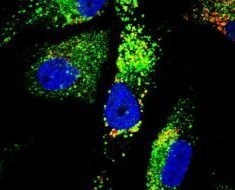The cause of smallpox is variola virus which is an example of an exclusive anthroponotic agent. This infectious disease plagued global health from the earliest documented settlements through nearly the end of the 20th century, with mortalities of 10–40%. It took the coordinated efforts of the world community (under the guidance of the World Health Organization) to successfully eradicate smallpox.
Classification
Variola virus is a member of the family Poxviridae, subfamily Chordopoxvirinae and genus Orthopoxvirus. The family Poxviridae comprises of two subfamilies – the Entomopoxvirinae and the Chordopoxvirinae, which infect insects and vertebrates, respectively.
In the genus Orthopoxvirus, 11 species that are antigenically and morphologically related can be found. These include eight Eurasian-African or Old World species and three North American or New World species. Only four of all those species represent significant human pathogens: variola virus, monkeypox virus, vaccinia virus and cowpox virus.
Aforementioned orthopoxviruses are immunologically cross-reactive and cross-protective, thus infection with any member of the genus provides protection against an infection with any other member. Variola and other orthopoxviruses contain an unexampled set of genes whose protein products effectively modulate the numerous defense functions of the host organisms.
Variola virus is the most notorious member of this genus and is differentiated into two phenotypic subtypes based on its case fatality. The variola major subtype produces a generalized rash that progresses from the papular to vesicular, and finally to pustular stages, with mortality higher than 30% in unvaccinated individuals. On the other hand, the variola minor subtype has a mortality rate of 1%.
At the genus level, the closest relative to variola virus is molluscum contagiosum, which is the only member in the genus Molluscipoxvirus. Although this virus is limited to human host as well, infetions with molluscum contagious are benign, resulting in single or multiple raised, pearl-like bumps (papules) on the skin.
Structure and genetics of the virus
Variola virus is a large brick-shaped particle that measure about 300 by 250 by 200 nm. The virion contains an envelope, a surface membrane, a concave core and two lateral bodies. The envelope of the virus is made of modified Golgi membranes that contain viral-specific polypeptides, including hemagglutinin.
Within the core there is a single linear double-stranded DNA genome of approximately 186 kilobases, which displays cross-linked hairpin termini composed of single-stranded loops of 100 nucleotides and encodes about 200 proteins. The genome replication involves self-priming, leading to the formation concatemers that are isolated from infected cells and subsequently cleaved to make viral genomes.
Variola virus codes its own type IB topoisomerases, which releases superhelical tension generated by replication and transcription of the genome. Its lifecycle is complicated by having multiple infectious forms, with diverse mechanisms of cell entry.
Although variola virus and monkeypox virus are genetically and antigenically related, they differ in sequence within regions encoding host-range and virulence factors near the genome termini. In addition to molecular differences, those two viruses also have dissimilar host ranges.
Sources
- http://www.hindawi.com/journals/av/2012/524743/
- http://www.nejm.org/doi/full/10.1056/NEJMra020025
- http://www.ncbi.nlm.nih.gov/pmc/articles/PMC3498598/
- http://whqlibdoc.who.int/smallpox/9241561106_chp2.pdf
- http://www.sciencedirect.com/science/article/pii/S0969212609004699
- www.clinicalmicrobiologyandinfection.com/…/pdf
- Parker S, Schultz DA, Meyer H, Buller RM. Smallpox and Monkeypox viruses. In: Mahy BWJ, van Regenmortel MHV. Desk Encyclopedia of Human and Medical Virology. Academic Press, 2010; pp. 461-472.
Further Reading
- All Smallpox Content
- What is Smallpox?
- Smallpox Evolution
- Smallpox Prognosis
- Smallpox Prevention
Last Updated: Aug 23, 2018

Written by
Dr. Tomislav Meštrović
Dr. Tomislav Meštrović is a medical doctor (MD) with a Ph.D. in biomedical and health sciences, specialist in the field of clinical microbiology, and an Assistant Professor at Croatia's youngest university – University North. In addition to his interest in clinical, research and lecturing activities, his immense passion for medical writing and scientific communication goes back to his student days. He enjoys contributing back to the community. In his spare time, Tomislav is a movie buff and an avid traveler.
Source: Read Full Article





